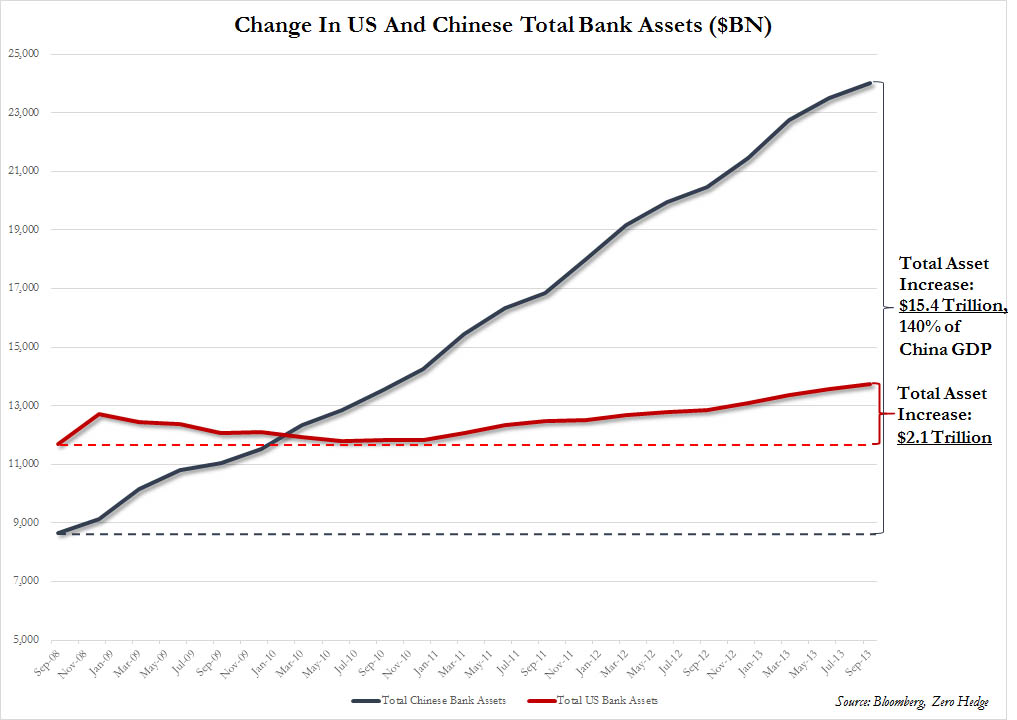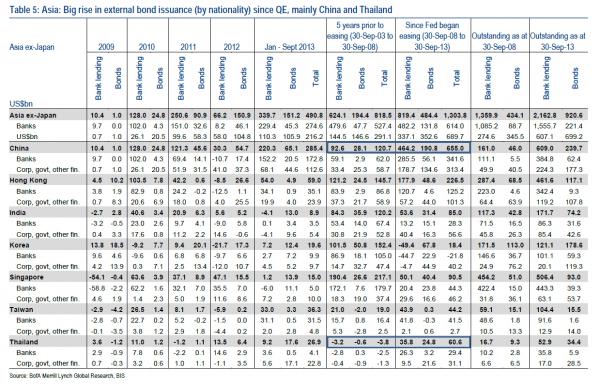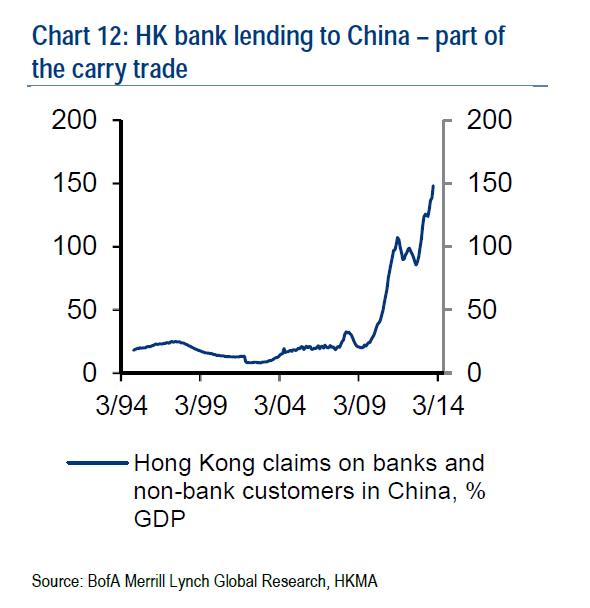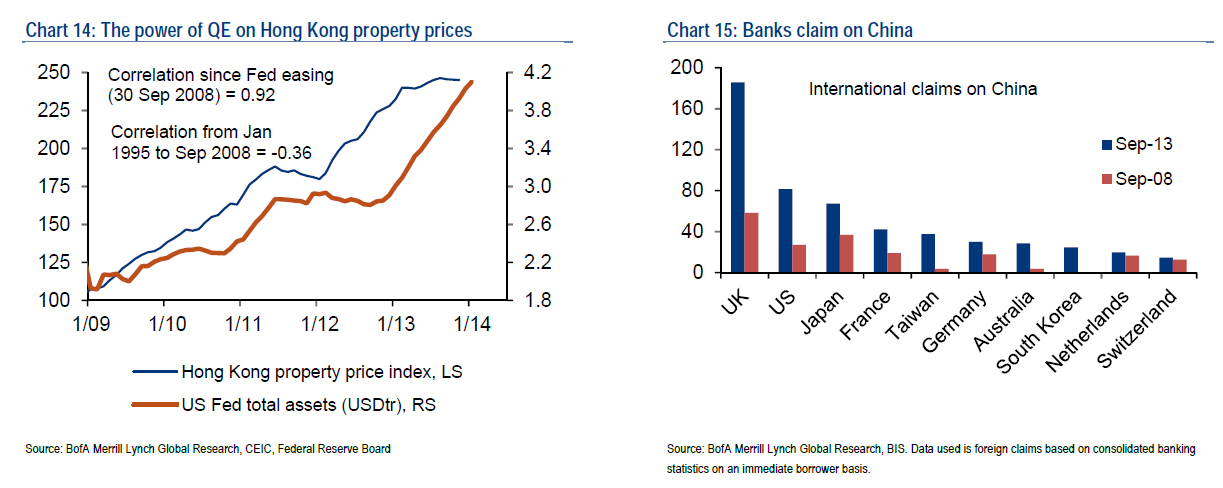– “The Pig In The Python Is About To Be Expelled”: A Walk Thru Of China’s Hard Landing, And The Upcoming Global Harder Reset (ZeroHedge, Feb 20, 2014):
By now everyone knows that the Chinese credit bubble has hit unprecedented proportions. If they don’t, we remind them with the following chart of total bank “assets” (read debt) added since the collapse of Lehman: China literally puts the US to shame, where in addition to everything, the only actual source of incremental credit growth over the same time period has been the Fed as banks have used reserves as margin for risk purchases instead of lending.
Everyone should also know that like a metastatic cancer, the amount of non-performing, bad loans within the Chinese financial system is growing at an exponential pace.
Finally, what everyone learned over the past month, is that as the two massive, and unresolvable forces, come to a head, the first cracks in the facade are starting to appear as first one then another shadow-banking Trust product failed and had to be bailed out in the last minute.
However, as we showed last week, and then again last night, the default party in China is only just beginning as Trust failures in the coming months are set to accelerate at a breakneck pace.
The $64K question is will the various forms of government be able to intercept and bail these out in time, as they have been doing so far despite their hollow promises of cracking down on moral hazard: after all, everyone certainly knows what happened when Lehman was allowed to meet its destiny without a bailout – to say that the CNY10 trillion Chinese shadow banking industry will not have far more dire consequences if allowed to fall without government support is simply idiotic.
But what could be the catalyst for this outcome which inevitably would unleash the long-overdue Chinese hard landing, and with it, a new global depression?
Ironically, the culprit may be none other than the Fed with the recently instituted taper, and the gradual, at first, then quite rapid unwind of the global carry trade.
Bank of America explains:
QE and the Emerging Markets carry trade
The QE channel has worked through Emerging Markets and China is a key vehicle. By lowering the US government bond yields to a bare minimum, and zero –ish at the short end, a search for yield globally ensued. Emerging market banks and corporates have gone on an international leverage binge, yet another carry trade, the third in 20 years. The first one was driven by European banks, financing East Asian capex – that ended in 1997. The second one was global banks and equity-FDI supporting mainly capex in the BRICs. That ended in 2008. This time, it is increasingly non-equity: commercial banks and more importantly, the bond market – often undercounted in the BoP and external debt statistics that conventional analysis looks at.
Chart 9 shows the rise of EM external loans and bond issuance (both by residence and nationality). Since, end-3Q2008 to end-3Q2013, external borrowing from banks and bonds has risen USD1.9tn. Bank loans have risen by USD855bn and bond issuance in foreign currencies by nationality is up USD1,042bn. In the prior five-year period (i.e. end-3Q2003 – end-3Q2008), forex bond issuance rose only USD432bn. Clearly, the importance of external bond issuance is rising. See Table 5 for details.
In China, since, end-3Q2008 to end-3Q2013, outstanding external borrowing from banks and bonds has gone from USD207bn to USD849n – a net rise of USD655bn. Outstanding bank loans are up from USD161bn to USD609bn – a net rise of USD464bn. Bond issuance in foreign currencies by nationality is up from USD46bn to USD240bn – a net rise of USD191bn. In the prior five-year period (ie, end-3Q2003 – end-3Q2008), forex bond issuance rose only USD28bn in China. Clearly, the importance of external bond issuance is rising in China.
There is more to this story.
As mentioned earlier, for externally-issued bonds, USD1,042bn has been raised by the nationality of the EM borrower since end-3Q 2008, but USD724bn by residence of the borrower – a gap of USD318bn, or 44%. This undercount is USD165bn in China, USD100bn in Brazil, USD62bn in Russia, and USD37bn in India. The carry trade this time around was helped substantially by access to the bond market, especially from overseas affiliates of EM banks and corporations.
There are a lot of moving parts in the balance of payments that finally affect the change in international reserves at any EM central bank – eg, the current account, portfolio equity investment and direct equity investment, and debt flows – both from the bond market and lending from banks. We focus on the link between these debt flows and the international reserves in China. As Table 5 below shows, China’s external debt – from bond issuance and forex borrowing from banks – rose USD655bn during 3Q08-3013.
We posit that this large rise was in part driven by the carry trade offered up by QE – China banks and corporates issued substantial forex-denominated bonds, and borrowed straight loans from international banks. We recognize the caveat that correlation does not imply causation. The USD655bn rise in China debt issuance is highly correlated to the Fed’s balance sheet since late-2008. As Chart 11 shows, the rise in China debt issuance of USD 655bn has (along with FDI and the C/A surplus), boosted international reserves by USD1,773bn since late-2008. Also, as Chart 11 shows, the USD1,773bn rise in China international reserves mirrors the rise of USD2,585bn in the EM monetary base. Lastly, the rise of China’s monetary base of USD2,585bn correlates well with the USD10.9tr rise in China’s broad money expansion.
As the Fed tapers, and the size of its balance sheet stabilizes/contracts, we should expect this sequence to reverse. Confidence is a fragile membrane. Not only does the Fed’s balance sheet matter as a source of funds, but we believe so does the attractiveness of the recipient of the carry trade – and the trust in its collateral. As Gary Gorton puts it…
The output of banks is money, in the form of short-term debt which is used to store value or used as a transaction medium. Such money is backed by a portfolio of bank loans in the case of demand deposits, or by collateral in the form of a specific bond in the case of repo. The backing is designed to make the bank debt as close to riskless as possible — in fact, so close to riskless than nobody wants to really do any due diligence on the money, just transact with it. But the private sector cannot produce riskless debt and so it can happen that the backing collateral is questioned. This typically happens at the peak of the business cycle. If its value is questioned, it loses its “moneyness” so no one wants it, and cash is preferred. But as we know, if everyone wants their cash at the same moment, their demands cannot be satisfied. In this sense, the financial system is insolvent. (interview with the FT)
What makes sense for an individual carry trade – borrow low, invest at higher rates – falls prey to the fallacy of composition, when too many engage in the same carry trade. And eventually question the underlying collateral, now huge, and potentially suspect. China is a case in point. If our colleagues David Cui and Bin Gao are right, the trust sector in China could create rollover risks that reverse a gluttonous carry trade within China, but partly financed overseas. In China’s case, this trade was between low global interest rates, low Chinese deposit rates, expectations of perpetual RMB appreciation on the one hand, and higher investment returns promised by Trusts on the other. A part of the debt funds raised overseas, we suspect were put to work in this Trust carry trade. The HK-based banks are big participants in intermediating the China carry trade – as Chart 12 shows, their net lending to China went from 18% of HK GDP in 2007 to 148% in late-2013.
There are always fancy names given to carry trades – financial liberalization of capital accounts, the Bangkok International Banking Facility, currency internationalization, etc. We remain skeptics of these buzzwords.
The potential consequences of Trust defaults and a China carry trade unwind
1. If the EM carry trade diminishes as a consequence of a changed Fed policy and/or less attractive risk-adjusted returns in EMs as collateral quality is questioned, the sources of China’s forex reserve accumulation will need to change. Perhaps to bigger current account surpluses, more equity FDI and portfolio investment through privatization and more open equity markets. If that does not happen, expanding the Chinese monetary base might require PBOC to increase net lending to the financial system and/or monetize fiscal deficits (this last part has not worked so well in EMs).
2. Potential asset deflation is a risk, as the carry trades diminish/unwind. Property prices are at risk – the collateral value for China’s financial systems. This is not a dire projection – it simply seeks to isolate the US QE as a key driver of China’s monetary policy and asset inflation, and highlights the magnitudes involved, and the transmission mechanism. Investors should not imbue stock-price movements and property price inflation in China with too much local flavor – this is mainly a US QE-driven story, in our view.
3. Currently, China’s real effective exchange rate is one of the strongest in the world. Concerns about China’s Trust sector, and its underlying collateral value, sees some of this carry trade unwound, the RMB could be under pressure.
4. Given HK’s role in the China carry trade, HK property prices and its banking system should be watched carefully for signs of stress.
5. UK, US, and Japan banking systems have been active lenders to China since QE. They should be on watch if the Trust rollover risk materializes and creates a growth shock in China. See Chart 15.
6. Safe haven bids for DM government bonds, overseas property and precious metals might emerge from China.
Could the party go on? Yes, if for some reason a significant deterioration in the US labor market, or a deflationary shock from China, or any other surprise that could lead to a cessation of the US tapering could prolong this carry trade. This is not the house base case. We believe it is better to start preparing for a post-QE world. As one of our smartest clients told us: “the main theme in the past five years was QE. If that is coming to an end, investments and themes that worked in the past five years must therefore be questioned.” We agree.
* * *
Yes, Bank of America said all of the above – every brutally honest last word of it.
The question, however, in addition to “why”, is whether the Fed also agrees with BofA’s stunningly frank, and quite disturbing conclusion, perhaps finally realizing that aside from the US, the biggest house of cards that would topple once the “flow”-free emperor is exposed in his nudity, is that of the world’s largest “growth” (and credit) dynamo of the past two decades – China. Because, as noted above, if Lehman’s collapse was bad, a deflationary collapse brought on by Chinese hard landing coupled with a full unwind of the global carry trade, would be disastrous and send the world into a depression the likes of which have never before been seen.
Finally, for those who want the blow by blow, here is BofA’s tentative take of what the preliminary steps of the next global great depression will look like:
If we do experience a sizable default, the knee-jerk market reaction will be cash hoarding since it will strike as a big surprise. Thus, we expect the repo rate to rise first, while the long term government bond would get bid due to risk aversion flows.
However, what follows will be quite uncertain, aside from PBoC injecting liquidity and easing monetary policy to help short term rate come down. It has been proven again and again the Chinese government will get involved and be proactive. The bond market reaction will be different depending on the government solution.
Alas, at that point, not even the world’s largest bazooka will be enough.
At this point one should conclude that reality – through massive, unprecedented liquidity injections – has been deferred long enough. It is time to let the markets finally return to some semblance of uncentrally-planned normalcy: there is a reason why nature abhors a vacuum. Even if it means the eruption of the very painful grand reset, washing away decades of capital misallocation, lies and ill-gotten wealth, so very overdue.










The entire world GDP averages $50-65 trillion a year (using their numbers). If one looks closer, it is far less than that in reality. 85% of all trades on the US stock exchange are high frequency……..a few individuals controlling huge funds (at least on paper) buy and sell large amounts of securities in less time than it takes to blink an eye. That is called skimming, not investing, and used to be illegal. Now, greedy guts skim the markets, leaving nothing behind…..not even a commission.
Only 15% of the US stock market is made up of real investors, and of the 15%…..we don’t know how many buy on margin. The real stock market is 10-15% of what is claimed.
China had a good system for a long time, but they made the mistake of adopting western policies, and their market is even more corrupt than the US.
What goes up, must come down. Chinese people no longer take care of their elderly, recently the Chinese courts gave parents the right to sue their children for livelihood. They have no social security because their culture used to embrace and honor their elders. No longer.
The same with medical care. If you have money, no problem. If you don’t, you die. The socialized medical care they had was dumped for western methods.
I find it ironic that our culture is the most destructive to others………
When China runs into trouble, they print more money just like the US.
This is a mess.
This doesn’t really surprise me.